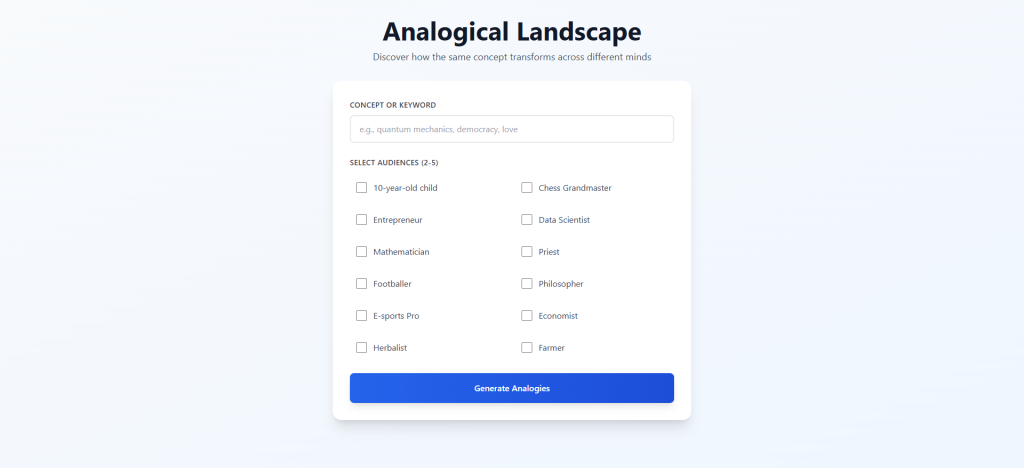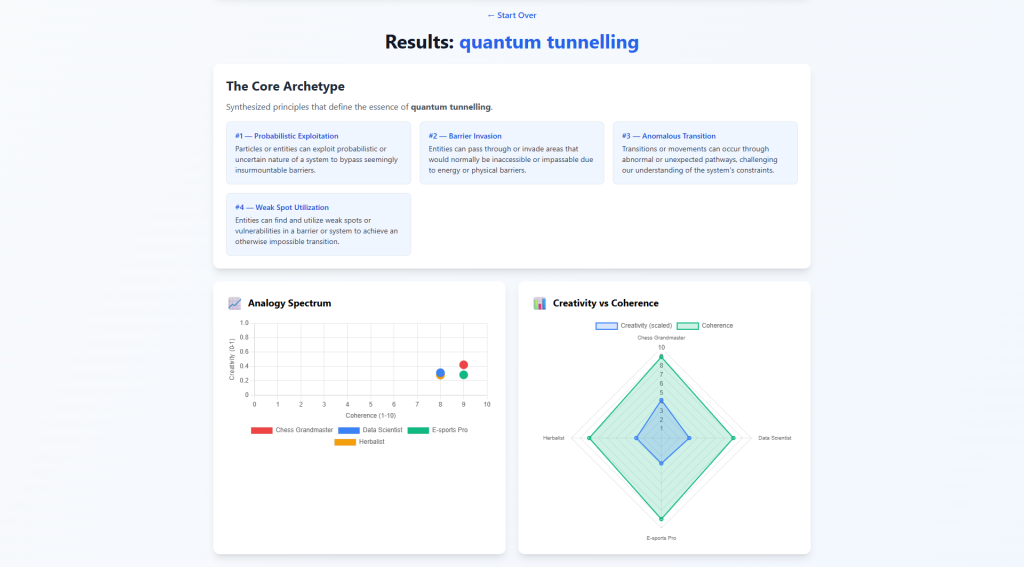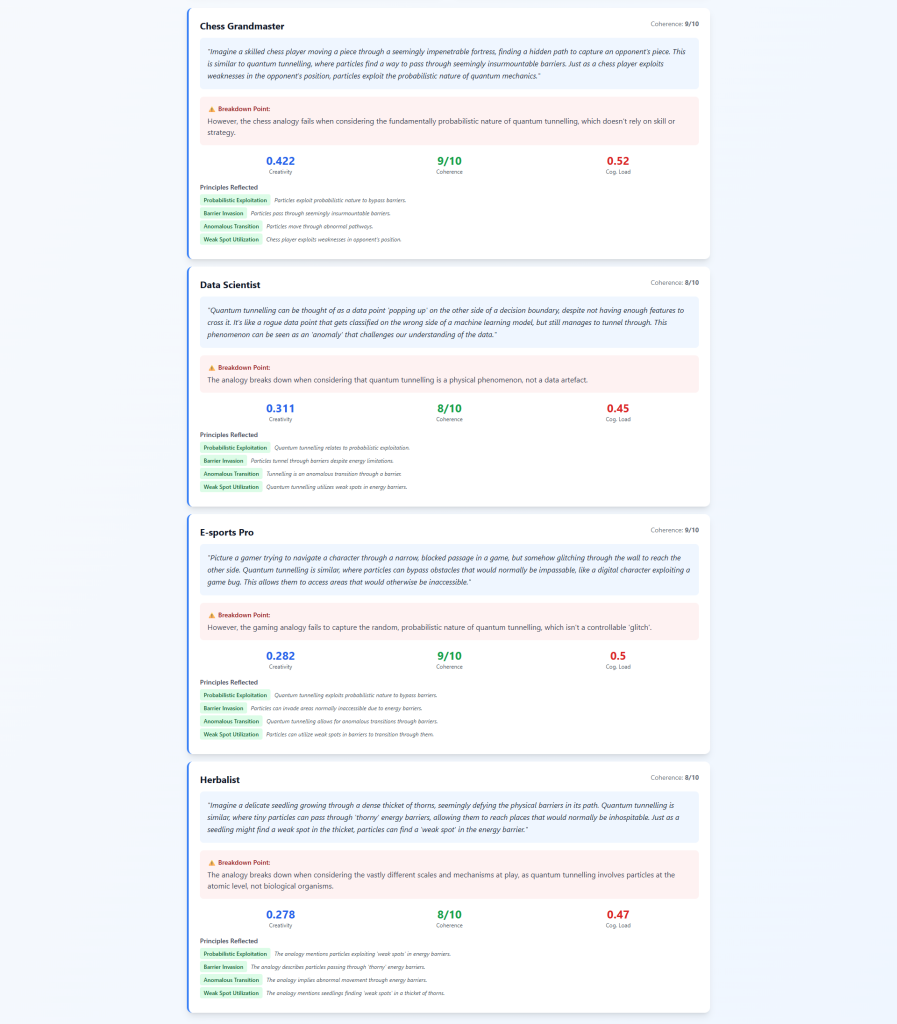We’ve all been there: faced with a complex idea, we reach for an analogy to make sense of it. “Quantum tunneling is like a ghost walking through a wall.” “A blockchain is like a public digital ledger.” Analogies are powerful tools for learning, but they are often imprecise and limited. Where one analogy illuminates, another can mislead.
But what if we could harness this process? What if, instead of relying on a single, flawed comparison, we could use a multitude of them to reverse-engineer the very essence of a concept?
I built Analogical Landscape, a tool designed to do exactly that. It’s more than just an analogy generator; it’s a concept-discovery engine. It takes a complex topic, views it through the eyes of completely different experts, and synthesizes those varied perspectives to uncover the fundamental, universal principles—the “Core Archetype”—that lie at the heart of the idea.

The “So What?” Deconstructing Complexity for Deeper Insight
The goal of this project is to answer a fundamental question: “What is this concept, really?”
By separating a concept’s core principles from its specific context, we unlock a more profound level of understanding. This matters because it transforms our relationship with knowledge.
- For Learning: Instead of memorizing one definition, you grasp the foundational rules that make a concept work, allowing you to apply it flexibly.
- For Communication: You can explain complex topics more effectively by understanding which facets will resonate with different audiences.
- For Innovation: By understanding the “archetype” of a strategy like “Blitzkrieg,” you can apply its principles of speed and precision to a business launch or a marketing campaign, domains far removed from the original.
Analogical Landscape is a tool for anyone who wants to move beyond surface-level descriptions to a deep, structural understanding of an idea.
How It Works: A Journey from Concept to Core Principles
The user experience is simple. You start by entering a concept and selecting 2-5 “audiences” or perspectives.
In the example from the screenshot, the concept is “quantum tunnelling,” and the chosen audiences include a Chess Grandmaster, a Data Scientist, an E-sports Pro, and an Herbalist.
The tool then performs a multi-stage analysis, powered by Large Language Models (LLMs), to produce a rich, interactive results page.
Stage 1: Generating the “Analogical Landscape”
First, the application calls an LLM to generate a unique analogy for each selected audience, including a critical “Breakdown Point” that clarifies the metaphor’s limits.
- For the Chess Grandmaster: Quantum tunneling is imagined as a piece finding a hidden path through a seemingly impenetrable defense.
- For the Data Scientist: It’s like a rogue data point “popping up” on the wrong side of a decision boundary in a machine learning model.
- For the E-sports Pro: It’s compared to a character “glitching” through a wall in a video game to reach an inaccessible area.
Stage 2: Synthesizing the Core Archetype
This is where the magic happens. The tool takes these diverse analogies and makes a second, analytical LLM call. The prompt for this call is, in essence: “Based on these different explanations, what are the 3-5 fundamental, domain-agnostic principles that define ‘quantum tunnelling’?”
The LLM synthesizes these shared patterns and presents the Core Archetype. For “quantum tunnelling,” it identified principles like:
- Probabilistic Exploitation: Entities can leverage uncertainty to bypass seemingly impossible barriers.
- Barrier Invasion: Entities can pass through or invade areas that would normally be impassable.
- Anomalous Transition: Movements can occur through unexpected pathways, challenging our understanding of a system’s constraints.
- Weak Spot Utilization: Entities can find and exploit vulnerabilities in a barrier to achieve an otherwise impossible transition.
This synthesized archetype is the “proof of value.” It transforms a collection of interesting metaphors into a powerful, actionable definition of the concept’s core mechanics.

# app.py: A simplified look at the archetype synthesis function
def synthesize_archetype(term, analogies):
# Gathers all the generated analogies into a list
examples = "\n".join(f"{a['audience']}: \"{a['analogy']}\"" for a in analogies)
prompt = (
f"Based on the following analogies for the concept '{term}', synthesize and extract the 3-5 "
f"fundamental, domain-agnostic principles that define the concept's core archetype. "
f"Return JSON only...\n\nAnalogies:\n{examples}"
)
# Make a second LLM call with this analytical prompt
completion = client.chat.completions.create(
model="llama-4-scout-17b-16e-instruct",
messages=[{"role": "user", "content": prompt}],
response_format={"type": "json_schema", ...}
)
parsed = json.loads(completion.choices[0].message.content)
return parsed["principles"]Stage 3: Visualizing the Landscape
To make the insights instantly understandable, the results are plotted on two charts:
- Analogy Spectrum: A scatter plot mapping each analogy’s Coherence (how logical it is) against its Creativity (how novel or unexpected it is). The top-right quadrant contains the most insightful analogies.
- Creativity vs. Coherence Radar Chart: This gives a quick, comparative overview of how the different audiences stack up across these two key metrics.
These visualizations provide an at-a-glance summary of which perspectives yielded the most effective explanations.

Where This Could Go Next
The “Analogical Landscape” framework is incredibly flexible and could be expanded into several exciting new directions:
- Strategic Business Analysis: Imagine feeding a competitor’s new strategy into the tool. By viewing it through the lenses of a “CFO,” “Marketing Lead,” and “Engineer,” a company could deconstruct the strategy’s core principles and devise a more effective response.
- Personalized Education: A student struggling with a concept in physics could select audiences like “Guitarist,” “Baker,” and “Novelist” to receive explanations that connect with their personal interests, along with the synthesized core principles to ensure they grasp the fundamentals.
- Creative Brainstorming: A writer or game designer could input a concept like “justice” and see how it’s interpreted by a “Soldier,” a “Priest,” and a “Child” to build more nuanced characters and worlds.
- Reverse Archetype Engine: A future version could allow users to input a set of principles (e.g., “decentralization,” “immutability,” “transparency”) and have the AI generate a list of real-world concepts that embody that archetype, acting as a powerful tool for discovery and innovation.
Let’s Build on This
I believe this approach—using multi-perspective analysis to uncover the core of an idea—has significant potential. The current tool is just the beginning. I am actively seeking collaborators, partners, and curious minds to explore where this technology can go, from enhancing educational platforms to building next-generation business intelligence tools.
If this project resonates with you or sparks an idea, I would be delighted to connect and discuss it further.
A live demo and the full source code for the project will be released shortly. You can watch the official GitHub repository for updates and be the first to know when it goes live: https://github.com/kongokega/analogical-landscape
